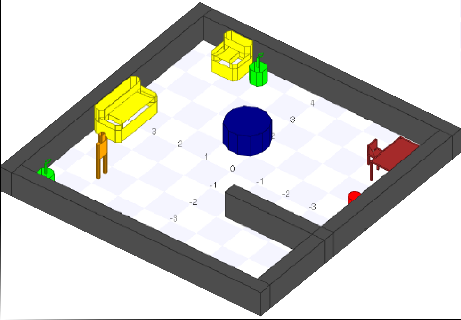Project description
Most robot programming environment to teach programming for kids and young people are highly visual, with drag and drop features. Thus, these interfaces can not be used by blind people or people with a severe visual impairment. The goal of this project it to propose a new assitive robot programming environment that can be used by blind people. In addition to the visual feedback normally provided by ordinary robot programming environment, the proposed system also provides sound and vibration feedback to the user.
The same system can also be used by blind users to learn and practice about orientation and mobility skills in a given floorplan in reduced scale. The user can practice how to move in a certain environment in reduced scale by using a simulated or a real robot. This way, when the user goes to the actual environment with the same floorplan, he/she will be able to remember the floorplan and move with more autonomy.


Goals
- Goal 1: provide an environment (hardware and software) to teach robot programming for blind people
- Goal 2: provide a tool to practive and improve the orientation and mobility skills of blind people
Milestones
- Milestone 1: build the robot hardware prototype (electronics and 3D models). 100%;
- Milestone 2: design robot’s Arduino protocol and firmware. 100%;
- Milestone 3: Integrate the robot computer (Rasp) with Player middleware and design Player drivers. 95%;
- Milestone 4: design parser and interpreter for new assisitive programming language called GoDonnie. 80%;
- Milestone 5: design simulation environment for Donnie using Stage. 90%;
- Milestone 6: test the software and hardware with blind people. 0%;
People
Coordinators
- Alexandre Amory, PUCRS.
- Isabel Harb Manssour
- Marcia Borba Campos
Academic Collaborators
- …
Students
- Juliana Damasio, Master student on Computer Science/PUCRS, advised by Marcia Campos, role: usability test, bibliography survey, tests with users.
- Augusto Cezar Peschke Bergamin, undergraduate student on Computer engineering/PUCRS, advised by Alexandre Amory, role: GoDonnie parser, Player/Stage models.
- Guilherme Henrique Marculino Marques, undergraduate student on Computer engineering/PUCRS, advised by Alexandre Amory, role: 3D models, electronics, Arduino and Raspberry Pi programming, Player device drivers.
- Camila Kolling dos Reis, undergraduate student on Computer engineering/PUCRS, advised by Marcia Campos, role: usability tests.
- Henry Nunes, undergraduate student on Computer Science/PUCRS, advised by Marcia Campos, role: usability tests.
- Joice Marek, undergraduate student on Computer Science/PUCRS, advised by Isabel Manssour, role: computer vision, visual odometry.
- Daniel Centeno Einloft, undergraduate student on Computer Science/PUCRS, advised by Isabel Manssour, role: computer vision, blob finder, Player driver.
Funding
- 2017: Chamada CNPq/MCTIC/SECIS Nº 20/2016 - TECNOLOGIA ASSISTIVA, BPA/PECDES
- 2016: Edital Interno FACIN, BPA/PECDES
- 2015: Edital Interno FACIN, BPA/PECDES
- 2014: Edital Interno FACIN, BPA/PECDES
Papers and Reports
- title and link. full bibio data is already available at …
Repositories
Main Resources
Hardware
- Raspberry Pi 2
- Arduino Mega
- Speakers
- Vibration motors
- Tacticle marks (3D printed)
Software
- Player middleware
- Stage simulator
- OpenCV
- Arduino programming
- Text to Speech
Media
Youtube videos demonstrating the working robot, both in simulation and the actual robot
